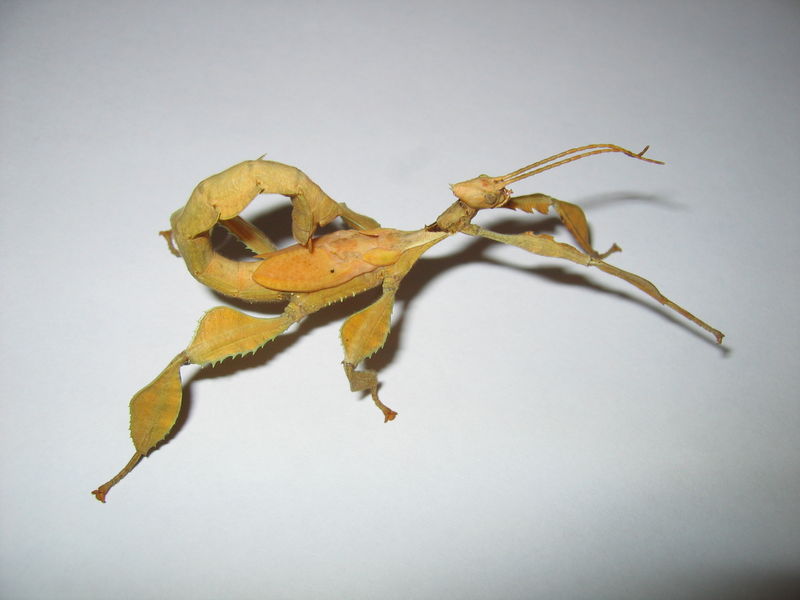Today I’ll introduce a member of a group of insects that have long fascinated me – the stick insects, or walking sticks. Several of the over 2,700 described species are well established in captivity, especially among European hobbyists. They are growing in popularity here in the USA also, most commonly, I’ve noticed, among reptile and amphibian keepers. (Note: laws governing the keeping of insects vary from country to country and state to state; please check those applicable to you before purchasing insect pets). 
Ants as Babysitters
Today’s insect hails from Australia and New Guinea (as do most truly bizarre creatures!). I’ll cover the husbandry of the giant spiny stick insect in the future…for now I’d like to provide you with a look at its most incredible reproductive strategy.
Female giant spiny stick insects lay approximately 12 eggs at a time, and may produce up to 1,000 or more during their lives. They fall to the ground after being quite forcibly ejected by the cloaca.
The eggs resemble seeds and are tipped with a structure known as a capitulum. The captiulum’s collar is a favored food of ants of the genus Leptomyrmex. The ants carry the eggs into their nest, where the collar is eaten. The stick insect’s eggs are then discarded in the ant colony’s underground rubbish pile, where, protected from predators and the fires that regularly ravage the forests above, they develop.
Tricking the Ants
The walking stick nymphs mimic Leptomyrmex ants in color (black body, red head) and move about in a rapid, frantic manner as do the ants (adult stick insects are slow moving). They also curl their abdomens up over the body, in the manner of their ant hosts.
Upon leaving the ant nest the stick insects moult, assume the adult body form and coloration, and climb into trees to live. All walking sticks undergo incomplete, or hemimetabolous, metamorphosis – there is no pupae stage.
A Variable Path to Reproduction
This species may reproduce either sexually or by parthenogenesis. Eggs produced via mating hatch in approximately 4 months, while those produced via parthenogenesis may take 9 months or more to hatch.
Strange, even for an insect, don’t you think? I’m always interested to hear about unique survival strategies…please write in with your own favorites and I’ll share them in future articles.
You can read more about this and related stick insects at:
http://www.novelguide.com/a/discover/grze_03/grze_03_00194.html#Macleays_spectre
Image referenced from Wikipedia and originally posted by Stephan M. Hohne
http://en.wikipedia.org/wiki/Image:Extatosoma_tiaratum_114.jpg
 That Reptile Blog – Reptile, Amphibian and Exotic Pet Care and Information
That Reptile Blog – Reptile, Amphibian and Exotic Pet Care and Information

 In 1969, Carl Kauffeld introduced a generation of budding herpetologists to snake-keeping with his wonderful classic
In 1969, Carl Kauffeld introduced a generation of budding herpetologists to snake-keeping with his wonderful classic  In my experience, small species are the best to start with when attempting naturalistic snake terrariums. Such animals are easier on plants and decorations, and secretive snakes really do seem much more “at home” in captive habitats that offer numerous burrowing and hiding opportunities.
In my experience, small species are the best to start with when attempting naturalistic snake terrariums. Such animals are easier on plants and decorations, and secretive snakes really do seem much more “at home” in captive habitats that offer numerous burrowing and hiding opportunities. In an odd twist of fate, I recently had the opportunity to help plan the complete renovation of Mr. Kauffeld’s amazing building. Having grown up near to and in awe of the man and the institution, it was quite an odd feeling, to say the least. I set up naturalistic exhibits for nearly all of the snakes, but a re-creation of Mr. Kauffeld’s office holds a number of terrariums set up as he would have wanted. I sincerely hope he approves! Please visit if you have a chance…I would greatly appreciate your comments.
In an odd twist of fate, I recently had the opportunity to help plan the complete renovation of Mr. Kauffeld’s amazing building. Having grown up near to and in awe of the man and the institution, it was quite an odd feeling, to say the least. I set up naturalistic exhibits for nearly all of the snakes, but a re-creation of Mr. Kauffeld’s office holds a number of terrariums set up as he would have wanted. I sincerely hope he approves! Please visit if you have a chance…I would greatly appreciate your comments. The bizarre Surinam toad needs little introduction to amphibian enthusiasts…their unique strategy of brooding the eggs below the skin of the female’s back has rendered the species quite well-known. Yet, when I received a group of adults in 1986, I found that little had been published on their husbandry, and the last recorded captive breeding seemed to have occurred in the 1950’s.
The bizarre Surinam toad needs little introduction to amphibian enthusiasts…their unique strategy of brooding the eggs below the skin of the female’s back has rendered the species quite well-known. Yet, when I received a group of adults in 1986, I found that little had been published on their husbandry, and the last recorded captive breeding seemed to have occurred in the 1950’s. The African bullfrog is notorious for its immense appetite and willingness to take on quite formidable prey, including venomous snakes, scorpions and centipedes (please see my article “An
The African bullfrog is notorious for its immense appetite and willingness to take on quite formidable prey, including venomous snakes, scorpions and centipedes (please see my article “An  Green anoles rarely live for long if maintained without full spectrum lighting. If a florescent bulb is used, be sure that all animals can bask within 12 inches of it (within 20 inches of the
Green anoles rarely live for long if maintained without full spectrum lighting. If a florescent bulb is used, be sure that all animals can bask within 12 inches of it (within 20 inches of the